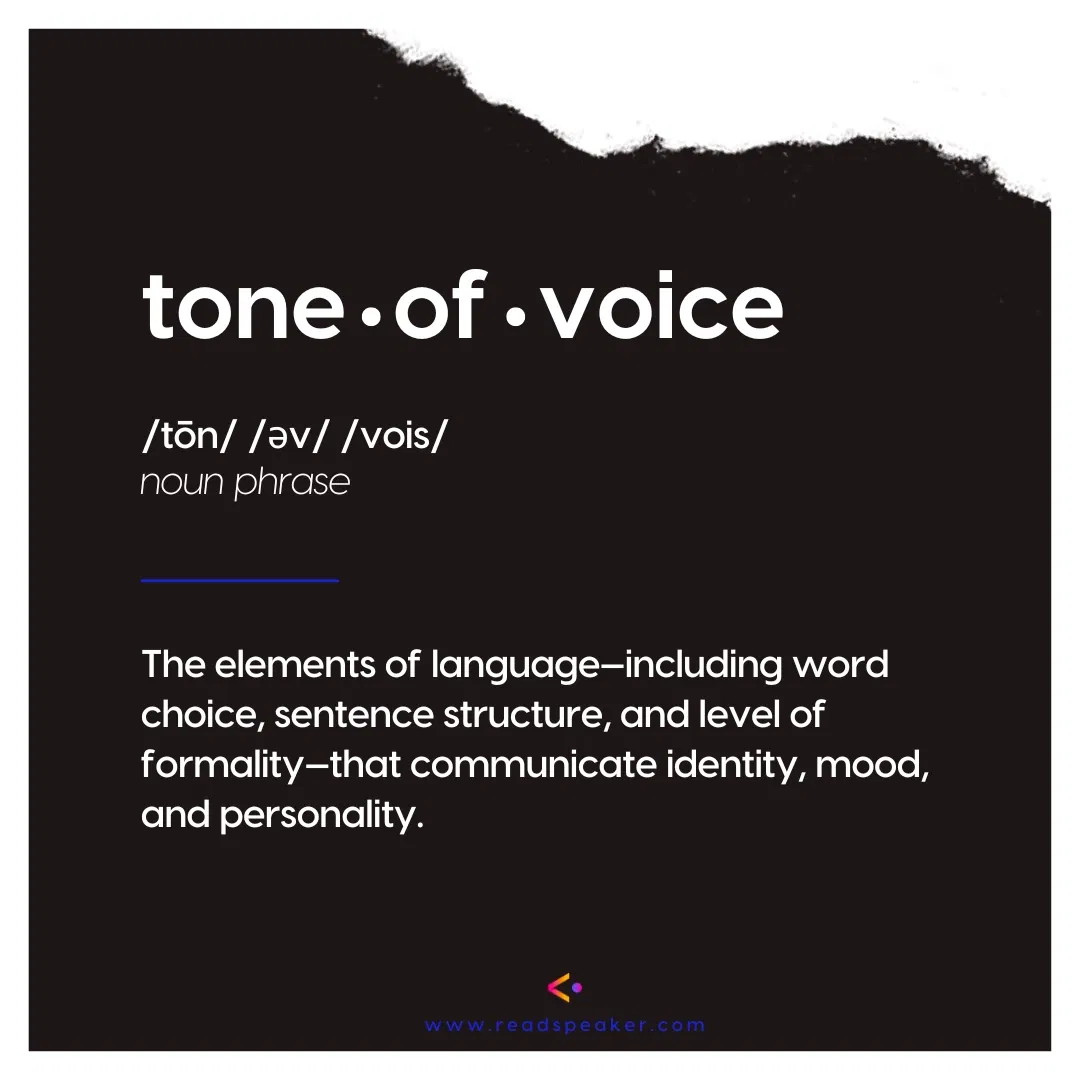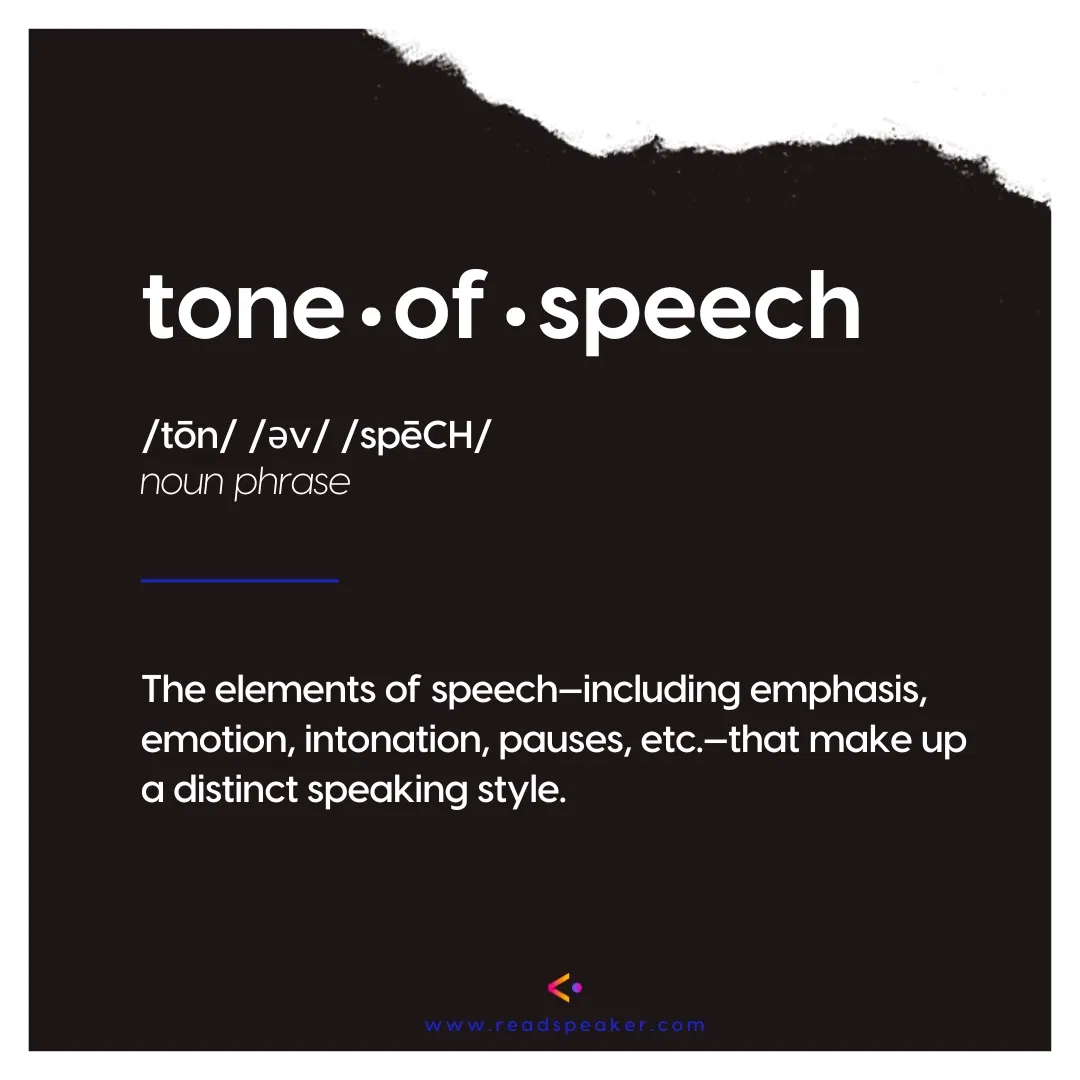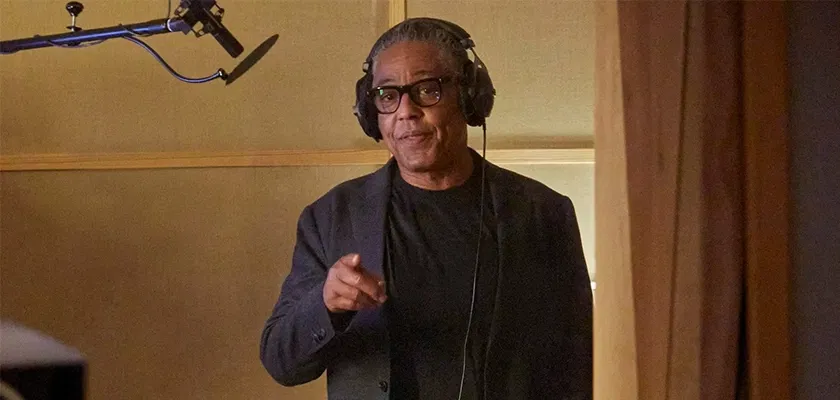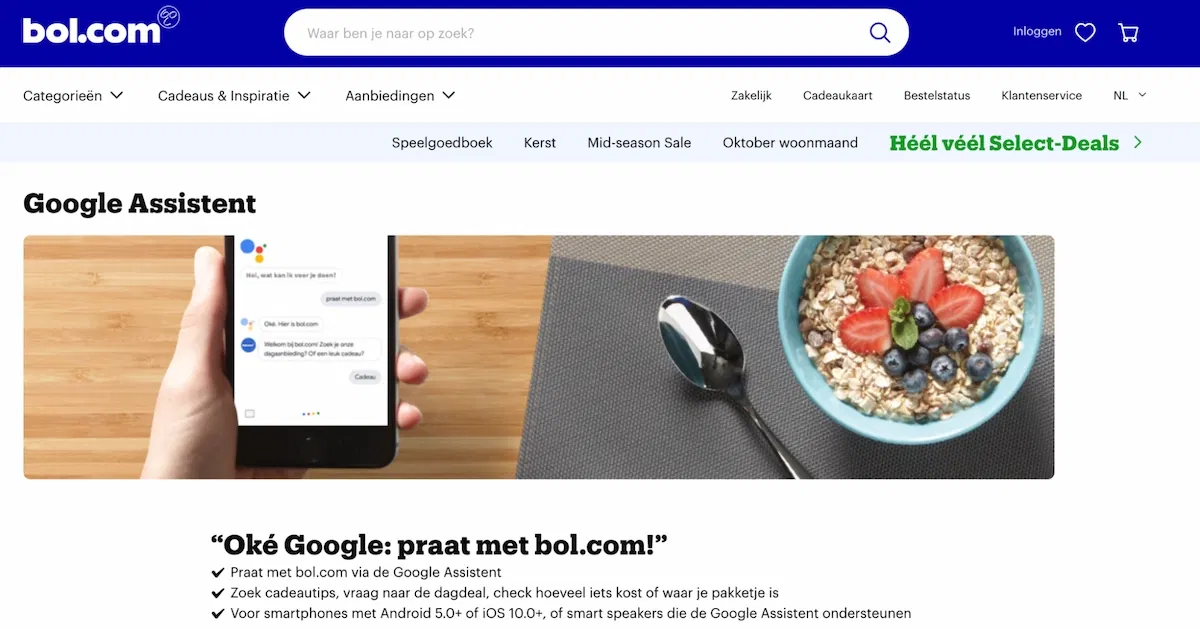
Your brand is defined by the features that set you apart from the competition, from names to logos to color schemes—and that includes a consistent, recognizable tone of voice. According to the International Standards Organization, the purpose of branding is to create “distinctive images and associations in the minds of stakeholders.” Your brand’s tone of voice is a powerful way to build these images and associations.
So it’s worth taking a moment to review tone of voice for corporate branding: What it is, why it matters, and how your written tone interacts with distinct speaking styles. The value of a strong tone of voice is growing as digital communication channels create more conversations between brands and consumers. At the same time, voicebots, smart speaker apps, virtual assistants, and other conversational AI platforms are changing the way consumers engage with companies. That can create confusion between two related but separate brand features: tone of voice and speaking style.
Here’s what you need to know to grow your brand through careful use of both tone of voice and speaking style, in written communications and through the Internet of Voice.
Looking for a TTS voice that uses tone to showcase your brand’s personality?
Talk to the experts at ReadSpeaker
What is tone of voice in communication for brands?
The quick definition is simple: Tone of voice is a consistent style of communication. But it’s most effective to control the technical details of tone, leaving nothing to chance. So here’s a more scientific definition of tone of voice:
Tone of voice refers to the elements of language that communicate identity, mood, and personality. It’s not the words themselves, but the style of presentation.

Tone of voice is how you express an idea, not the idea itself. You create a distinct tone of voice with word choice, sentence structure, point of view, and even punctuation. These style choices must align with your brand values. For instance, if you sell energy drinks, you’ll probably want a direct, informal, second-person voice: “You gotta try this stuff!” If you sell business insurance, you’ll probably want a more formal, technical voice: “In today’s uncertain economic environment, every business owner needs protection from liability.”
However you design your tone of voice—and you should absolutely write a tone guide for communications staff—the key is consistency. To create a strong brand association, tone has to remain the same across channels. If you use a lot of jokes on social media, crack wise on your webpage. If your brand is authoritative and serious, keep language formal from the blog to the newsletter.
Of course, language exists in two forms: speech and writing. Tone of voice for branding applies to both. After all, most brand speech starts on the page. But we also differentiate between tone of voice—word choice, sentence structure, level of formality, all the elements you can identify in a script or a print ad—and distinct speaking styles, the use of tone when speaking. Call this speaking style tone of speech. (For more on tone of voice in marketing, see our article about negative tone examples marketers should avoid.)

What is tone of speech in brand communications?
While a well-defined tone of voice influences the words you say, the tone of speech describes how you say them. The first guides how you write a script and the second characterizes the performance. Essentially, tone of speech is for speaking what tone of voice is for writing—although, of course, the two overlap frequently, as written texts become speech and vice versa.
Let’s break that down a bit. Speech scientists call the words within speech “linguistic information.” That’s the content of the message. Tone of speech includes everything but this linguistic information. Elements of a speaking style include emphasis, emotion, inflection, intonation, pauses, “ums” and “likes,” and the unique sound of the individual voice. You can sum it all up as a speaking style. For brands, that speaking style directly affects the relationship with consumers.
Speaking Style, Emotion, and Brand Personality
Speaking style, emotion, and personality are closely related. When we describe a style of speech, we also describe emotion: We perceive speech as happy, sad, angry, etc. so when creating a synthetic voice companies should strive to get as close as possible to a real human connection between a company identity and the consumer. Emotion is the connective tissue that gets the job done. To understand how speaking styles tie into emotional connections with brands—and consumer experiences more generally—imagine this scenario:
You’re calling your bank to make your final credit card payment—a debt you’ve been working to pay off for years. When you make the call, you’ll hear one of two things:
- “Hey, congratulations! That’s quite an achievement. We’ll send a $10 gift card just to say thanks. Would you like to talk about a higher credit limit?”
- ”Payment accepted. Anything else?”
We know which experience we’d rather have. The first agent will probably keep your loyalty. The second might lose your business altogether. That’s a pretty direct connection between tone of voice, speech content, and brand reputation. Casual interactions matter, too, whether that’s through an online voicebot or an interactive voice ad on your customer’s favorite music streaming service.
The theory of brand personality helps explain why. According to marketing theorist Jennifer Aaker, brand personality is “the set of human characteristics associated with a brand.” In her research, Aaker lists personality traits that line up with specific types. A “sincere” personality shows traits of honesty, cheerfulness, and domesticity. A “rugged” brand is tough and outdoorsy. Other brand dimensions include excitement, competence, and sophistication—all of which are expressed through specific personality traits.
Here’s the thing about those traits: They’re each associated with different voice characteristics. A rugged voice may be low and gravelly. A sincere voice sounds honest and upbeat. Regardless of the personality itself, tone of voice gives listeners an idea about who the speaker is. It’s a direct line to identity.
A distinct voice with an appropriate speaking style expresses this identity. Whether you’re training customer service agents or building a TTS voice, strive to create a speaking tone that matches your brand’s personality—especially when you scale that voice across all your audio channels, from in-store announcements to smart speaker apps to automated phone systems. You need a text-to-speech (TTS) voice that represents your brand and your brand alone. Tone of speech is a big part of that effort.
Controlling Speaking Styles with AI-Powered Text to Speech
ReadSpeaker is not a branding agency (although we do work closely with them!), so we don’t give advice about how to construct your brand identity from scratch. But we are a custom digital voice design leader with a strong research wing that’s always pushing the science of TTS to exciting new places. That makes us the perfect partner to bring your unique voice to life, however it best reflects your brand identity.
In fact, we specialize in crafting custom, one-of-a-kind TTS voices—and a branded voice is crucial for any company that uses voice computing to interact with consumers. Although the alternative may be to pick a generic or default TTS voice from a tech giant like Amazon or Google, there a couple risks to this approach:
- You don’t own brand equity. If you go with the standard Alexa voice for your branded Alexa skill, consumers won’t think about your brand when they use it. Instead, they’ll think about Amazon.
- You run the risk of using the same voice as a direct competitor. That’s the opposite of carving out your own branding niche. An independent digital voice partner like ReadSpeaker helps your brand stand out, with a unique voice that does for the ears what your logo does for the eyes.
This brings us to speaking styles in TTS, which is an important part of a brand’s synthetic voice. ReadSpeaker gives your business several ways to adjust style while designing your TTS voice. These options include:
- Emotionally expressive TTS. As in human-to-human communication, emotional tone must match the context of each conversation. That’s why neural TTS voices from ReadSpeaker can speak in different moods. The same voice can sound sympathetic, excited, or even angry—and, in addition, if you work with one of our partners to include emotion recognition tools, today’s conversational platforms can switch emotional tones to match the user’s mood, just like people do.
- Appropriate emphasis. “GET on that bus,” has a slightly different meaning than “Get on THAT bus.” The first is a directive from someone in charge (and maybe a bit annoyed), while the second could show which bus, or suggest it’s urgent that you get on the bus now, or you might miss it. At ReadSpeaker, we can build custom emphasis into your company’s TTS voice to support a certain mood or personality.
- Speaking speed and rhythm. An energy drink brand may wish to express excitement and adventure; that TTS voice should speak a bit faster than a bank’s. Pauses in speech also contribute to a sense of identity; “I…think so” is less sure than “I think so!” Your brand TTS voice should use these elements to convey its distinct character. With TTS from ReadSpeaker, it can.
Listen to a few examples of these TTS tone of voice characteristics on our demo page.
While you’re there, check out our cross-lingual TTS capabilities, which allow your brand voice to speak multiple languages. But to really understand how control over tone of voice in TTS can create better customer connections, you need some real-world examples. Keep reading for a few actual use cases that illustrate the importance of tone of voice in TTS-based brand interactions.
5 Examples of Speaking Styles in TTS Interaction
Human speakers control style without thinking. A great customer service agent will express sympathy, encouragement, or neutral professionalism through the way they speak, and change their tone from one call to the next. Thanks to cutting-edge AI technology, TTS voices can do the same, creating a more human experience and more positive brand interactions every time.
What does a distinct TTS style look like in action? Here are a few examples.
1. Giancarlo Esposito for Sonos Voice Control
The team behind Sonos Voice Control knew exactly whose voice they wanted to interact with Sonos listeners: that of legendary actor Giancarlo Esposito. Sonos partnered Esposito and ReadSpeaker’s custom voice unit, VoiceLab, to synthesize a lifelike digital version of this unmistakable voice.
Users of Sonos smart speakers now hear Esposito’s voice every time they use the device, so they recognize the brand instantly. Thanks to Esposito’s many recording sessions and ReadSpeaker’s advanced deep neural networks, this custom TTS voice speaks with a natural, consistent, and friendly style—and accurately pronounces words in multiple languages.

2. Ana, the AI Assistant in Augmented Reality Game “Acolyte”
When game studio Superstring Ltd. began to develop the augmented reality game “Acolyte,” developers ran into a technology barrier. Gameplay centers on interactions between the player and an AI assistant named Ana. The game uses natural language AI, so players can say anything to Ana, and she’ll come up with an original response on the spot.
That meant the studio couldn’t record voiceovers for Ana. ReadSpeaker provided the solution with a plug-in that brings runtime TTS to the Unity and Unreal game engines. With ReadSpeaker’s TTS Unity plug-in, Superstring gave Ana a distinctive voice—one that allows her to say anything her natural language generation (NLG) software comes up with.
“The tonality of the voice was important to get right,” said Jamin Smith, director and lead designer at Superstring Ltd. “With the right pitch, pauses, and emphases, certain scenes in the game suddenly feel so much more poignant and emotional. The TTS made the questions about what lies underneath Ana’s programming really pop, and the game is far stronger for it.”
3. ZOE, MSC Cruises’ On-Board Virtual Assistant
In 2019, MSC Cruises introduced ZOE, the world’s first digital voice assistant for guests on luxury cruise ships. ZOE lives on in-cabin smart speakers, providing quick, up-to-date answers about ship services, from activities to restaurant guides. ReadSpeaker’s lifelike TTS voice gives ZOE a personality that’s friendly, sophisticated, and mildly upbeat: perfect for helping guests enjoy their trip. ZOE speaks seven languages, and you can listen to the assistant’s UK English voice below to get an idea of the tone.
4. bol.com’s Google Assistant Voice App
When leading Dutch online retailer bol.com built its Google Assistant shopping app, the company made plans to drive brand equity. Those plans included a custom TTS voice developed by ReadSpeaker. The bol.com voice is warm, masculine, and self-assured. It sounds like a friendly personal shopper, which, in a way, it is—and it may find its way onto other voice-enabled consumer touchpoints soon. That will create a consistent brand experience from Google Assistant to the customer service call center and beyond. Listen to examples of bol.com’s custom TTS voice here.

5. Adam, ReadSpeaker’s Conversational British English Voice
If you’re looking for an example of a friendly, engaging TTS voice that speaks British English, look no further than ReadSpeaker’s Adam. Adam was created on ReadSpeaker’s proprietary deep neural networks. This advanced AI computing architecture accurately models human speech, leading to extremely lifelike synthetic speech.
Adam exhibits the conversational style in TTS speech, ideal for voicebots and other conversational AI applications. While the Adam voice is not attached to any one brand, it’s a powerful illustration of the level of humanity ReadSpeaker achieves in all our custom branded voices. Listen to Adam introduce himself below.
In the first two of these examples, the TTS voice represents a distinct identity that users come to associate with the brand. Conversations create human connections (even when one of the speakers is a machine). That’s just how we’re wired, and both tone of voice and distinct speaking styles contribute to stronger brand relationships—independently, as on the page, and both at once through the Internet of Voice.
Want to learn more about all the ways a TTS voice can help with your branding?
Reach out to start the conversation


